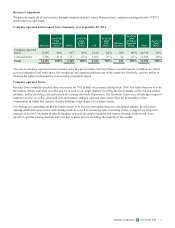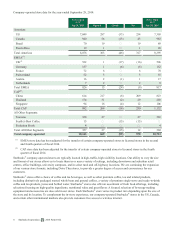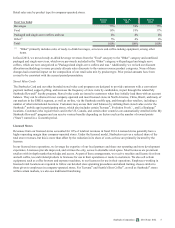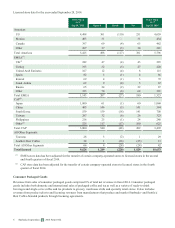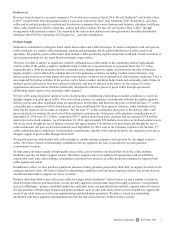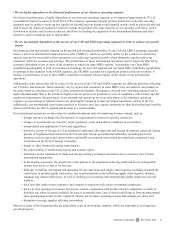Starbucks 2014 Annual Report Download - page 17
Download and view the complete annual report
Please find page 17 of the 2014 Starbucks annual report below. You can navigate through the pages in the report by either clicking on the pages listed below, or by using the keyword search tool below to find specific information within the annual report.
Starbucks Corporation 2014 Form 10-K 13
•
•
•
•
•
•
•
•
• We are highly dependent on the financial performance of our Americas operating segment.
Our financial performance is highly dependent on our Americas operating segment, as it comprised approximately 73% of
consolidated total net revenues in fiscal 2014. If the Americas operating segment revenue trends slow or decline our other
segments may be unable to make up any significant shortfall and our business and financial results could be adversely affected.
And because the Americas segment is relatively mature and produces the large majority of our operating cash flows, such a
slowdown or decline could result in reduced cash flows for funding the expansion of our international business and other
initiatives and for returning cash to shareholders.
• We are increasingly dependent on the success of our CAP and EMEA operating segments in order to achieve our growth
targets.
Our future growth increasingly depends on the growth and sustained profitability of our CAP and EMEA operating segments.
Some or all of our international market business units ("MBUs"), which we generally define by the countries in which they
operate, may not be successful in their operations or in achieving expected growth, which ultimately requires achieving
consistent, stable net revenues and earnings. The performance of these international operations may be adversely affected by
economic downturns in one or more of the countries in which our large MBUs operate. In particular, our China MBU
contributes meaningfully to both net revenues and earnings for our CAP segment and our Japan MBU contributes significantly
to earnings in that segment. In the EMEA segment, our UK MBU accounts for a significant portion of the net revenues. A
decline in performance of any of these MBUs could have a material adverse impact on the results of our international
operations.
Additionally, some factors that will be critical to the success of the CAP and EMEA segments are different than those affecting
our US stores and licensees. Tastes naturally vary by region, and consumers in some MBUs may not embrace our products to
the same extent as consumers in the US or other international markets. Occupancy costs and store operating expenses can be
higher internationally than in the US due to higher rents for prime store locations or costs of compliance with country-specific
regulatory requirements. Because many of our international operations are in an early phase of development, operating
expenses as a percentage of related revenues are often higher compared to more developed operations, such as in the US.
Additionally, our international joint venture partners or licensees may face capital constraints or other factors that may limit the
speed at which they are able to expand and develop in a certain market.
Our international operations are also subject to additional inherent risks of conducting business abroad, such as:
• foreign currency exchange rate fluctuations, or requirements to transact in specific currencies;
• changes or uncertainties in economic, legal, regulatory, social and political conditions in our markets;
• interpretation and application of laws and regulations;
• restrictive actions of foreign or US governmental authorities affecting trade and foreign investment, especially during
periods of heightened tension between the US and such foreign governmental authorities, including protective
measures such as export and customs duties and tariffs, government intervention favoring local competitors, and
restrictions on the level of foreign ownership;
• import or other business licensing requirements;
• the enforceability of intellectual property and contract rights;
• limitations on the repatriation of funds and foreign currency exchange restrictions due to current or new US and
international regulations;
• in developing economies, the growth rate in the portion of the population achieving sufficient levels of disposable
income may not be as fast as we forecast;
• difficulty in staffing, developing and managing foreign operations and supply chain logistics, including ensuring the
consistency of product quality and service, due to governmental actions affecting supply chain logistics, distance,
language and cultural differences, as well as challenges in recruiting and retaining high quality employees in local
markets;
• local laws that make it more expensive and complex to negotiate with, retain or terminate employees;
• delays in store openings for reasons beyond our control, competition with locally relevant competitors or a lack of
desirable real estate locations available for lease at reasonable rates, any of which could keep us from meeting annual
store opening targets and, in turn, negatively impact net revenues, operating income and earnings per share; and
• disruption in energy supplies affecting our markets.
Moreover, many of the foregoing risks are particularly acute in developing countries, which are important to our long-term
growth prospects.


